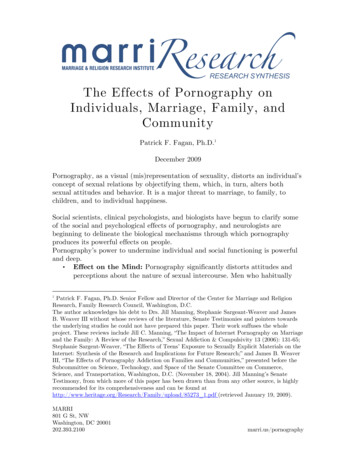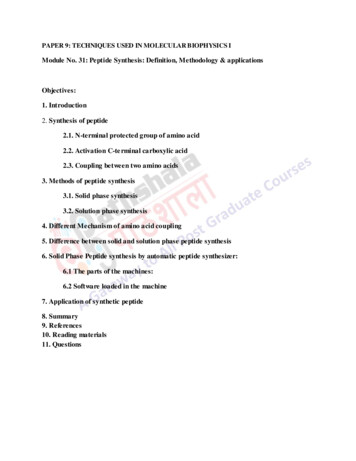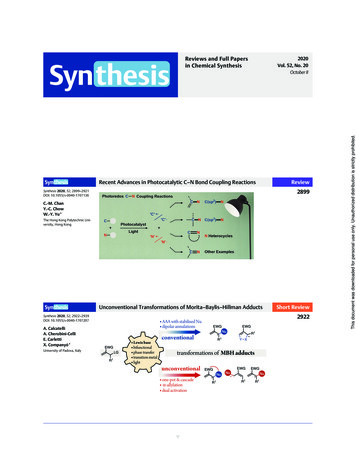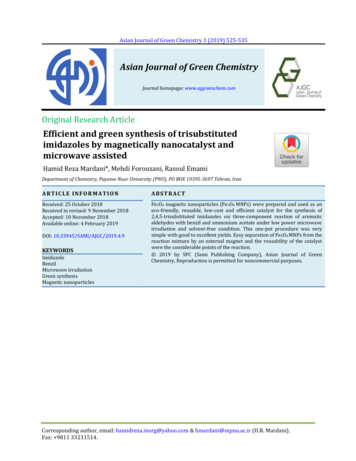
Transcription
RESEARCH SYNTHESISThe Effects of Pornography onIndividuals, Marriage, Family, andCommunityPatrick F. Fagan, Ph.D.1December 2009Pornography, as a visual (mis)representation of sexuality, distorts an individual’sconcept of sexual relations by objectifying them, which, in turn, alters bothsexual attitudes and behavior. It is a major threat to marriage, to family, tochildren, and to individual happiness.Social scientists, clinical psychologists, and biologists have begun to clarify someof the social and psychological effects of pornography, and neurologists arebeginning to delineate the biological mechanisms through which pornographyproduces its powerful effects on people.Pornography’s power to undermine individual and social functioning is powerfuland deep. Effect on the Mind: Pornography significantly distorts attitudes andperceptions about the nature of sexual intercourse. Men who habitually1Patrick F. Fagan, Ph.D. Senior Fellow and Director of the Center for Marriage and ReligionResearch, Family Research Council, Washington, D.C.The author acknowledges his debt to Drs. Jill Manning, Stephanie Sargeant-Weaver and JamesB. Weaver III without whose reviews of the literature, Senate Testimonies and pointers towardsthe underlying studies he could not have prepared this paper. Their work suffuses the wholeproject. These reviews include Jill C. Manning, “The Impact of Internet Pornography on Marriageand the Family: A Review of the Research,” Sexual Addiction & Compulsivity 13 (2006): 131-65;Stephanie Sargent-Weaver, “The Effects of Teens’ Exposure to Sexually Explicit Materials on theInternet: Synthesis of the Research and Implications for Future Research;” and James B. WeaverIII, “The Effects of Pornography Addiction on Families and Communities,” presented before theSubcommittee on Science, Technology, and Space of the Senate Committee on Commerce,Science, and Transportation, Washington, D.C. (November 18, 2004). Jill Manning’s SenateTestimony, from which more of this paper has been drawn than from any other source, is highlyrecommended for its comprehensiveness and can be found 5273 1.pdf (retrieved January 19, 2009).MARRI801 G St, NWWashington, DC 20001202.393.2100marri.us/pornography
look at pornography have a higher tolerance for abnormal sexualbehaviors, sexual aggression, promiscuity, and even rape. In addition, menbegin to view women and even children as “sex objects,” commodities orinstruments for their pleasure, not as persons with their own inherentdignity.Effect on the Body: Pornography is very addictive. The addictiveaspect of pornography has a biological substrate, with dopamine hormonerelease acting as one of the mechanisms for forming the transmissionpathway to pleasure centers of the brain. Also, the increased sexualpermissiveness engendered by pornography increases the risk ofcontracting a sexually transmitted disease or of being an unwitting parentin an out-of-wedlock pregnancy.Effect on the Heart: Pornography affects people’s emotional lives.Married men who are involved in pornography feel less satisfied with theirmarital sexual relations and less emotionally attached to their wives.Women married to men with a pornography addiction report feelings ofbetrayal, mistrust, and anger. Pornographic use may lead to infidelity andeven divorce. Adolescents who view pornography feel shame, diminishedself-confidence, and sexual uncertainty.I. IntroductionThe conjugal act—the act of sexual intercourse—brings humanity into existenceand sets in motion the next generations of society. Sexual intercourse, like atomicenergy, is a powerful agent for good if channeled well, but for ill if not. Healthysocieties maintain their stability by channeling the sexual energies of youngadults into marriage, an institution that legitimizes sexual intercourse, protectsthe children that are the fruit of intercourse, and channels the giving andreceiving of sexual pleasure in a way that builds up rather than tears downsociety. Sexual taboos are one set of the normal mechanisms of social control ofthe sexual appetite. They are analogous to the control rods of a nuclear reactorplant: they block the sexual from straying off course and into destructivepathways.One of the biggest tasks of adolescent members of all society is to come to gripswith their burgeoning sexuality. Some have always tested the limits of sexualexpression even when strong social controls were in place. In well-orderedsocieties, such testing triggers immediate social sanctions from parents, mentors,and community.In today’s media-saturated society, these sanctions operate in fewer and fewerquarters. A substantial factor in this shift has been the growth of digital mediaand the Internet. This “digital revolution” has led to great strides in productivity,communication, and other desirable ends, but pornographers also have harnessedits power for their profit. The cost has been a further weakening of the nation’s2
citizens and families, a development that should be of grave concern to all. Thesocial sciences demonstrate the appropriateness of this concern.Two recent reports, one by the American Psychological Association on hypersexualized girls, and the other by the National Campaign to Prevent TeenPregnancy on the pornographic content of phone texting among teenagers, makeclear that the digital revolution is being used by younger and younger children todismantle the barriers that channel sexuality into family life.2Pornography hurts adults, children, couples, families, and society. Amongadolescents, pornography hinders the development of a healthy sexuality, andamong adults, it distorts sexual attitudes and social realities. In families,pornography use leads to marital dissatisfaction, infidelity, separation, anddivorce. Society at large is not immune to the effect of pornography. Child sexoffenders, for example, are often involved not only in the viewing, but also in thedistribution, of pornography.Pornography is powerful enough even to overwhelm individuals, couples, andfamilies despite earlier affectionate relationships—whether between the motherand father or between the parents and the child. But loving family relationshipscan help mute many of the factors that encourage the use of pornography longbefore its addictive power takes root in a user’s life.The effect of regular viewing of pornography on marriage and family is dealt withfirst, for there its greatest damage to the innocent can be seen. Then the sourceof this damage is reviewed: the effects on the individual user, his psyche, and hisbehavior. Adolescent usage, patterns, and effects are then delineated, for duringthis period the habit of viewing pornography is often developed in stages. Finallythe effects of sexually-oriented-businesses on their local environs are reviewed.II. Family Consequences of ViewingPornographyPornography has significant effects during all stages of family life. For a childexposed to pornography within a family setting, pornography causes stress andincreases the risk for developing negative attitudes about the nature and purposeof human sexuality. For adolescents who view pornography, their attitudestoward their own and others’ sexuality change, and their sexual expectations andbehavior are shaped accordingly. For adults, pornography has harmful and evendestructive effects on marriage.2Report of the APA Task Force on the Sexualization of Girls, American PsychologicalAssociation, Washington D.C., 2008 at http://www.apa.org/pi/wpo/sexualizationrep.pdf; and:National Campaign to Prevent Teen and Unplanned Pregnancy: “SEX And TECH, Results froma survey of teens and young adults,” Washington D.C., 2008 exTech Summary.pdf.3
A. Impact on ChildrenThe impact of a parent’s use of pornography on young children is varied anddisturbing. Pornography eliminates the warmth of affectionate family life, whichis the natural social nutrient for a growing child. Other losses and traumasrelated to the use of pornography when a child is young include: encountering pornographic material a parent has acquired; encountering a parent masturbating; overhearing a parent engaged in “phone sex”; witnessing and experiencing stress in the home caused by online sexualactivities; increased risk of the children becoming consumers of pornographythemselves; witnessing and being involved in parental conflict; exposure to the commodification of human beings, especially women, as“sex objects”; increased risk of parental job loss and financial strain; increased risk of parental separation and divorce; decreased parental time and attention—both from the pornographyaddicted parent and from the parent preoccupied with the addictedspouse.3Also, parents may disclose their struggle with the addiction to pornography totheir children, intentionally or unintentionally, thereby distorting their children’ssexual development.4B. Impact on AdolescentsPornography viewing among teenagers disorients them during that developmentalphase when they have to learn how to handle their sexuality and when they aremost vulnerable to uncertainty about their sexual beliefs and moral values.5 Astudy of 2,343 adolescents found that sexually explicit Internet materialsignificantly increased their uncertainties about sexuality.6 The study also showedthat increased exposure to sexually explicit Internet material increased favorableattitudes toward sexual exploration with others outside of marriage anddecreased marital commitment to the other spouse.7 Another study by Todd G.Morrison, professor of psychology at the University of Saskatchewan, and3Jennifer P. Schneider, “Effects of Cybersex Addiction on the Family: Results of a Survey,”Sexual Addiction & Compulsivity 7 (2000): 31-58.4M. Deborah Corley and Jennifer P. Schneider, “Sex Addiction Disclosure to Children: TheParents’ Perspective,” Sexual Addiction & Compulsivity 10 (2003): 291-324.5Jochen Peter and Patti M. Valkenburg, “Adolescents’ Exposure to Sexually Explicit InternetMaterial, Sexual Uncertainty, and Attitudes Toward Uncommitted Sexual Exploration: Is There aLink?” Communication Research 35 (2008): 579-601 (581).6Peter and Valkenburg, “Adolescents’ Exposure to Sexually Explicit Internet Material,” 596.7Peter and Valkenburg, “Adolescents’ Exposure to Sexually Explicit Internet Material,” 595.4
colleagues found that adolescents exposed to high levels of pornography hadlower levels of sexual self-esteem.8A significant relationship also exists between frequent pornography use andfeelings of loneliness, including major depression.9Finally, viewing pornography can engender feelings of shame: In a study of highschool students, the majority of those who had viewed pornography felt somedegree of shame for viewing it. However, 36 percent of males and 26 percent offemales said they were never ashamed of viewing pornography,10 giving some ideaof the level of desensitization already reached in society.High adolescent consumption of pornography also affects behavior. Malepornography use is linked to significantly increased sexual intercourse with nonromantic friends,11 and is likely a correlate of the so-called “hook-up” culture.Exposure to pornographic sexual content can be a significant factor in teenagepregnancy. A three year longitudinal study of teenagers found that frequentexposure to televised sexual content was related to a substantially greaterlikelihood of teenage pregnancy within the succeeding three years. This samestudy also found that the likelihood of teenage pregnancy was two times greaterwhen the quantity of that sexual content exposure, within the viewing episodes,was high rather than low.128Todd G. Morrison, Shannon R. Ellis, Melanie A. Morrison, Anomi Bearden, and Rebecca L.Harriman, “Exposure to Sexually Explicit Material and Variations in Body Esteem, GenitalAttitudes, and Sexual Esteem Among a Sample of Canadian Men,” The Journal of Men’s Studies14 (2006): 209-22 (216-7).9Michele L. Ybarra and Kimberly J. Mitchell, “Exposure to Internet Pornography amongChildren and Adolescents: A National Survey,” CyberPsychology & Behavior 8 (2005): 473-86(479).Vincent Cyrus Yoder, Thomas B. Virden III, and Kiran Amin “Internet pornography andLoneliness: An Association?” Sexual Addiction & Compulsivity 12 (2005): 19-44 (30). This was astudy of 400 individual Internet pornography users.10Thomas Johansson and Nils Hammarén, “Hegemonic Masculinity and Pornography: YoungPeople’s Attitudes Toward and Relations to Pornography,” The Journal of Men’s Studies 15(2007): 57-70 (64).11E. Häggström-Nordin, U. Hanson, and T. Tydén, “Associations between PornographyConsumption and Sexual Practices among Adolescents in Sweden,” International Journal of STD& AIDS 16 (2005): 102-7 (104-5).12Anita Chandra, Steven C. Martino, Rebecca L. Collins, Marc N. Elliott, Sandra H. Berry,David E. Kanouse, and Angela Miu, “Does Watching Sex on Television Predict Teen Pregnancy?Findings from a Longitudinal Survey of Youth,” Pediatrics 122 (2008): 1047-1054 (1052).5
C. Impact on MarriageMarital Dissatisfaction. Pornography use undermines marital relations anddistresses wives.13 Husbands report loving their spouses less after long periods oflooking at (and desiring) women depicted in pornography.14In many cases, the wives of pornography users also develop deep psychologicalwounds, commonly reporting feelings of betrayal, loss, mistrust, devastation, andanger in responses to the discovery or disclosure of a partner’s pornographiconline sexual activity.15Wives can begin to feel unattractive or sexually inadequate and may becomeseverely depressed when they realize their husbands view pornography.16 Thedistress level in wives may be so high as to require clinical treatment for trauma,not mere discomfort.17Viewers of pornography assign increased importance to sexual relations withoutemotional involvement,18 and consequently, wives experience decreased intimacyfrom their husbands.19The emotional distance fostered by pornography and “cybersex” (interactivecomputer contact with another regarding pornographic sexual issues) can oftenbe just as damaging to the relationship as real-life infidelity,20 and both men andwomen tend to put online sexual activity in the same category as having anaffair.21 The estrangement between spouses wrought by pornography can havetangible consequences as well: when the viewing of pornography rises to the level13Ana J. Bridges, Raymond M. Bergner, and Matthew Hesson-McInnis, “Romantic Partners’ Useof Pornography: Its Significance for Women,” Journal of Sex & Marital Therapy 29 (2003): 1-14.14Dolf Zillmann and Jennings Bryant, “Pornography’s Impact on Sexual Satisfaction,” Journal ofApplied Social Psychology 18 (1988): 438-53 (439-440), quoting S.E. Gutierres, D.T. Kenrick, andL. Goldberg (1983, August), Adverse effect of popular erotica on judgments of one’s mate, Paperpresented at the annual meeting of the American Psychological Association, Anaheim, CA15Schneider, “Effects of Cybersex Addiction on the Family,” 31-58.16Schneider, “Effects of Cybersex Addiction on the Family,” 38.17Barbara A. Steffens and Robyn L. Rennie, “The Traumatic Nature of Disclosure for Wives ofSexual Addicts,” Sexual Addiction & Compulsivity 13 (2006): 247–67.18Zillmann and Bryant, “Pornography’s Impact on Sexual Satisfaction,” 448.19Raymond M. Bergner and Ana J. Bridges, “The Significance of Heavy PornographyInvolvement for Romantic Partners: Research and Clinical Implications,” Journal of Sex &Marital Therapy 28 (2002): 193-206 (197).20J.P. Schneider, “Effects of Cybersex Problems on the Spouse and Family,” Sex and the Internet:A Guidebook for Clinicians, ed. A. Cooper (New York: Brunner-Routledge, 2002): 169-86 (180).21Monica Therese Whitty, “Pushing the Wrong Buttons: Men’s and Women’s Attitudes towardOnline and Offline Infidelity,” CyberPsychology & Behavior 6 (2003): 569-79.6
of addiction, 40 percent of “sex addicts” lose their spouses, 58 percent sufferconsiderable financial losses, and about a third lose their jobs.22In a study on the effects of “cybersex”—a form of sexually explicit interactionbetween two people on the Internet—researchers found that more than half ofthose engaged in “cybersex” had lost interest in sexual intercourse, while one-thirdof their partners had lost interest as well, while in one-fifth of the couples bothhusband and wife or both partners had a significantly decreased interest in sexualintercourse. Stated differently, this study showed that only one-third of couplesmaintained an interest in sexual relations with one another when one partner wasengaged in “cybersex.”23Prolonged exposure to pornography also fosters dissatisfaction with, and evendistaste for, a spouse’s affection.24 Cynical attitudes regarding love begin toemerge, and “superior sexual pleasures are thought attainable without affectiontoward partners.”25 These consequences hold for both men and women who havehad prolonged exposure to pornography, with the decline in sexual happinessbeing primarily due to the growing dissatisfaction with the spouse’s normalsexual behavior.26Finally, pornography users increasingly see the institution of marriage as sexuallyconfining,27 have diminished belief in the importance of marital faithfulness,28 andhave increasing doubts about the value of marriage as an essential socialinstitution and further doubts about its future viability.29 All this naturallydiminishes the importance for them of having good family relations in their ownfamilies.30Increased Infidelity. Dolf Zillman of the University of Alabama, in one studyof adolescents, shows that the steady use of pornography frequently leads toabandonment of fidelity to their girlfriends.31 Steven Stack of Wayne StateUniversity and colleagues later showed that pornography use increased the22Mary Anne Layden, Ph.D. (Center for Cognitive Therapy, Department of Psychiatry,University of Pennsylvania), Testimony for U.S. Senate Committee on Commerce, Science andTransportation, November 18, 2004, 2.23Schneider, “Effects of Cybersex Addiction on the Family,” 39-40.24James B. Weaver III, “The Effects of Pornography Addiction on Families and Communities”(Testimony presented before the Subcommittee on Science, Technology, and Space of the SenateCommittee on Commerce, Science, and Transportation, Washington, D.C., November 18, 2004),4.25Dolf Zillmann, “Influence of Unrestrained Access to Erotica on Adolescents’ and Young Adults’Dispositions toward Sexuality,” Journal of Adolescent Health 27S (2000): 41-44 (42).26Zillmann and Bryant, “Pornography’s Impact on Sexual Satisfaction,” 448.27Zillmann, “Influence of Unrestrained Access to Erotica,” 42.28Zillmann and Bryant, “Pornography’s Impact on Sexual Satisfaction,” 448.29Weaver, “The Effects of Pornography Addiction on Families and Communities,” 4.30Zillmann and Bryant, “Pornography’s Impact on Sexual Satisfaction,” 448.31Dolf Zillmann, “Influence of Unrestrained Access to Erotica,” 42.7
marital infidelity rate by more than 300 percent.32 Another study found a strongcorrelation between viewing Internet pornography and sexually permissivebehavior.33 Stack’s study found that Internet pornography use is 3.7 times greateramong those who procure sexual relations with a prostitute than among thosewho do not.34“Cybersex” pornography also leads to much higher levels of infidelity amongwomen. Women who engaged in “cybersex” had about 40 percent more offlinesexual partners than women who did not engage in cybersex.35Separation and Divorce. Given the research already cited, it is not surprisingthat addiction to pornography is a contributor to separation and divorce. In thebest study to date (a very rudimentary opportunity study of reports by divorcelawyers on the most salient factors present in the divorce cases they handled), 68percent of divorce cases involved one party meeting a new paramour over theInternet, 56 percent involved “one party having an obsessive interest inpornographic websites,” 47 percent involved “spending excessive time on thecomputer,” and 33 percent involved spending excessive time in chat rooms (acommonly sexualized forum).36 Cybersex, which often takes place in these chatrooms, was a major factor in separation and divorce: In over 22 percent of thecouples observed the spouse was no longer living with the “cybersex” addict, andin many of the other cases spouses were seriously considering leaving themarriage or relationship.37III. Differences between Men and WomenPornography affects both men and women. However there are significantdifferences between men and women on the likelihood of using pornography, thetypes of pornography used, and their feelings about pornography.32Steven Stack, Ira Wasserman, and Roger Kern, “Adult Social Bonds and Use of InternetPornography,” Social Science Quarterly 85 (2004): 75-88.33Ven-hwei Lo and Ran Wei, “Exposure to Internet Pornography and Taiwanese Adolescents’Sexual Attitudes and Behavior,” Journal of Broadcasting & Electronic Media 49 (2005): 221-37(229).34Steven Stack, Ira Wasserman, and Roger Kern, “Adult Social Bonds and Use of InternetPornography,” Social Science Quarterly 85 (2004): 75-88 (83).35Kristian Daneback, Al Cooper, and Sven-Axel Månsson, “An Internet Study of CybersexParticipants,” Archives of Sexual Behavior 34 (2005): 321-28 (324-25).36Jill Manning, Senate Testimony, November 10, 2005, referencing: J. Dedmon, “Is the Internetbad for your marriage? Online affairs, pornographic sites playing greater role in divorces,” 2002,press release from American Academy of Matrimonial Lawyers, 14.37Schneider, “Effects of Cybersex Addiction on the Family,” 56.8
A. Different Rates of Use and Different Types of UseMen and women use pornography differently. Men are more than six times aslikely to view pornography as females,38 and more likely to spend more timeviewing it.In a study of self-identified female “cybersex” addicts, women reported that theypreferred engaging in “cybersex” within the context of a relationship (via email orchat room) rather than accessing pornographic images. This preference maycontribute to the significant difference one study found in the proportion ofwomen who have real-life sexual encounters with their online companionscompared to men. It found that 80 percent of women who engaged in these onlinesexual activities also had real-life sexual encounters with their online partners,compared to the much lower proportion of 33 percent for men.39 Also, as statedabove, such women are much more likely to have had very high numbers of suchsexual encounters and partners.40 However in another study, this time of men whoflirted in Internet chat rooms, 78 percent reported they had at least one face-toface sexual experience with someone they had met through a chat room in thepast year.41 Thus, it seems that a very high proportion of both men and womenwho engage in “cybersex” may go on to have physical sexual encounters with theironline partners.A study of sex-addicted men also found that 43 percent used online sexualactivity to engage in sexual activities they would never otherwise perform.42Similarly, self reports also reveal that the tendency to explore new behaviors in“offline” relationships increases with increased online sexual activity.43B. Different Reactions to Different InfidelitiesThe way men and women view infidelity is very different. One study, usingundergraduates from a large university in Northern Ireland, investigated howmen and women perceive online and offline sexual and emotional infidelity. Whenforced to decide, men were more upset by sexual infidelity and women byemotional infidelity. Only 23 percent of women claimed they would be more38Steven Stack, Ira Wasserman, and Roger Kern, “Adult Social Bonds and Use of InternetPornography,” Social Science Quarterly 85 (2004): 75-88 (85).39Jennifer P. Schneider, “A Qualitative Study of Cybersex Participants: Gender Differences,Recovery Issues, and Implications for Therapists,” Sexual Addiction & Compulsivity 7 (2000):249–78 (277).40Kristian Daneback, Al Cooper, and Sven-Axel Månsson, “An Internet Study of CybersexParticipants,” Archives of Sexual Behavior 34 (2005): 321-28 (324-25).41Brian Dew, Michael Brubaker, and Danica Hays, “From the Altar to the Internet: Married Menand Their Online Sexual Behavior,” Sexual Addiction & Compulsivity 13 (2006): 195-207 (199).42Al Cooper, Nathan Galbreath, and Michael A. Becker, “Sex on the Internet: Furthering ourUnderstanding of Men with Online Sexual Problems,” Psychology of Addictive Behavior 18 (2004):223-30 (225).43Al Cooper, Nathan Galbreath, and Michael A. Becker, “Sex on the Internet: Furthering ourUnderstanding of Men with Online Sexual Problems,” 226.9
bothered by sexual infidelity, compared to the 77 percent of women who wouldbe more bothered by emotional infidelity. Males felt the opposite way. Eightyfour percent of the men reported they would be more bothered by sexualinfidelity, whereas only 16 percent say they would be more bothered by emotionalinfidelity.44In a study which examined different types of degrading pornography, featuringthemes such as “objectification” and “dominance,” both men and women rated thesame three major themes as the most degrading of all, but with differentintensities: women rated them as even more degrading than men did.45IV. Individual Consequences of ViewingPornographyPornography changes the habits of the mind, the inner private self. Its use caneasily become habitual, which in turn leads to desensitization, boredom, distortedviews of reality, and an objectification of women. A greater amount of sexualstimuli becomes necessary to arouse habitual users, leading them to pursue moredeviant forms of pornography to fulfill their sexual desires.A. Desensitization, Habituation, and BoredomProlonged use of pornography produces habituation,46 boredom, and sexualdissatisfaction among female and male viewers,47 and is associated with morelenient views of extramarital sexual relations and recreational attitudes towardsex.48 A 2000 study of college freshmen found that the habitual use ofpornography led to greater tolerance of sexually explicit material, thus requiringmore novel and bizarre material to achieve the same level of arousal or interest.49For example, habituation may lead to watching “depictions of group sex,sadomasochistic practices, and sexual contact with animals,”50 engaging in analintercourse,51 and trivializing “nonviolent forms of the sexual abuse of children.”5244Monica T. Whitty and Laura-Lee Quigley, “Emotional and Sexual Infidelity Offline and inCyberspace,” Journal of Marital and Family Therapy 34 (2008): 461-468 (465).45Gloria Cowan and Kerri F. Dunn, “What Themes in Pornography Lead to Perceptions of theDegradation of Women?” The Journal of Sex Research 31 (1994): 11-21 (16-17).46Dolf Zillman, Indiana University, Paper prepared for the Surgeon General’s Workshop onPornography and Public Health, Arlington VA, 1986. Available athttp://profiles.nlm.nih.gov/NN/B/C/K/V/ /nnbckv.pdf (accessed April 23, 2012).47Weaver, “The Effects of Pornography Addiction on Families and Communities,” 2, 4.48Ven-hwei Lo and Ran Wei, “Exposure to Internet Pornography and Taiwanese Adolescents’Sexual Attitudes and Behavior,” Journal of Broadcasting & Electronic Media 49 (2005): 221-37(230); Jochen Peter and Patti M. Valkenburg, “Adolescents’ Exposure to Sexually Explicit OnlineMaterial and Recreational Attitudes toward Sex,” Journal of Communication 56 (2006): 639-660(654).49Zillmann, “Influence of Unrestrained Access to Erotica,” 41.50Weaver, “The Effects of Pornography Addiction on Families and Communities,” 3.51Häggström-Nordin, Hanson, and Tydén, “Associations between Pornography Consumption andSexual Practices among Adolescents in Sweden,” 104-5.10
The pornography industry adapted to this desire for more bizarre and uncommonimages. An analysis of the content of Playboy, Penthouse, and Hustler from theyears 1953 to 1984 revealed 6,004 child images and an additional 14,854 imagesdepicting crime or violence. Furthermore, nearly two-thirds of the child imageswere sexual and violent, with most of the images displaying girls between theages of three and eleven years of age. Each of these magazines portrayed thescenes involving children as though the child had been unharmed by the sexualscene or even benefited from it.53Heavy exposure to pornography leads men to judge their mates as sexually lessattractive,54 resulting in less satisfaction with their affection, physical appearance,and sexual behavior.55 The need for more intense sexual stimulation brought onby pornography can lead to boredom in normal relationships and a greaterlikelihood of seeking sexual pleasure outside of marriage. Repeated exposure topornography leads the viewer to consider “recreational sexual engagements” asincreasingly important,56 and changes the viewer to being very accepting of sexualpermissiveness.57B. Distorted Perception of RealityPornography presents sexual access as relentless, “a sporting event that amountsto innocent fun” with inconsequential effects on emotions, perceptions, andhealth.58 This is not the case, however. Pornography leads to distortedperceptions of social reality: an exaggerated perception of the level of sexualactivity in the general population,59 an inflated estimate “of the incidence ofpremarital and extramarital sexual activity, as well as increased assessment ofmale and female promiscuity,” “an overestimation of almost all sexual activitiesperformed by sexually active adults,”60 and an overestimation of the generalprevalence of perversions such as group sex, bestiality, and sadomasochisticactivity.61 Thus the beliefs being formed in the mind of the viewer of pornographyare far removed from reality. A case could be made that repeated viewing ofpornography induces a mental illness in matte
MARRI 801 G St, NW Washington, DC 20001 202.393.2100 marri.us/pornography The Effects of Pornography on Individuals, Marriage, Family, and Community











